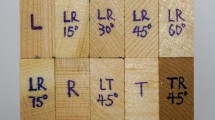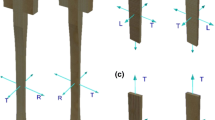Abstract
Comprehensive test series, mainly based on German standards, were carried out to determine elasto-mechanical properties and hygroscopic behaviour of Pinus durangensis Martinez. Where ASTM standards required specimen sizes which differed widely from DIN specimens, tests were carried out also according to ASTM standards. Pinus durangensis was found to have a slightly higher density than Pinus sylvestris L. For this reason some elasto-mechanical properties as well as swelling and shrinking were greater than for P. sylvestris L. Growth characteristics, quantity and distribution of defects are similar for both species. Therefore, if the same grading system is applied, the same coefficients can be used for both species or for comparable pines from growth areas in temperate zones.
Zusammenfassung
Zur Bestimmung der Festigkeitseigenschaften und des hygroskopischen Verhaltens des Holzes von Pinus durangensis Martinez wurden umfangreiche Prüfserien, im wesentlichen auf der Grundlage deutscher Normen, durchgeführt. In den Fällen, bei denen die Probenformen erheblich von jenen abwichen, die in den nordamerikanischen ASTM-Normen gefordert sind, wurde zusätzlich nach ASTM geprüft. Die Rohdichte von P. durangensis wurde als etwas höher liegend als diejenige von P. sylvestris L. festgestellt. Aus diesem Grund lagen auch einige physikalisch-mechanische und hygroskopische Eigenschaften höher als bei P. sylvestris. Die Charakteristik des Wuchses ebenso wie die Verteilung und Anzahl von sog. Holzfehlern sind bei beiden Arten ähnlich. Sofern das gleiche Sortiersystem verwendet wird, können für beide Holzarten dieselben Materialfaktoren eingesetzt werden, desgleichen für vergleichbare Pinus-Arten der gemäßigten Zonen.
Similar content being viewed by others
Literatur
Becker, H. 1973: Measuring the moduli of rigidity of solid wood by torsional vibration test Holz Roh-Werkstoff 31:207–210
Bröker, F.-W. 1984: Tensile strength of spruce perpendicular to the grain under different load directions. Holz Roh-Werkstoff 42:474
Hörig, H. 1935: Application of the theory of elasticity of an anisotropic body for measuring the elastic constants of wood. Ingenieurarchiv 6:8–14
Kollmann, F.; Côté, W. 1969: Principles of wood science and technology. Vol. I, Solid wood. Berlin/Heidelberg/New York: Springer
Martinez, M., 1948: The Mexican pine: Mexico, Ediciones Botas
Schwab, E.; Polaczek, P. 1977: Measuring the moduli of rigidity of solid wood by static torsional tests. Holz Roh-Werkstoff 35:23–27
Author information
Authors and Affiliations
Additional information
The wood was put at our disposal, free of charge, by the Compania Maderera del Guadiana, Durango/Mexico
Rights and permissions
About this article
Cite this article
Roth, W.v., Rechy de v. Roth, M.d.l.A. Important structural properties of pinus durangensis martinez. Holz als Roh-und Werkstoff 44, 41–46 (1986). https://doi.org/10.1007/BF02606150
Issue Date:
DOI: https://doi.org/10.1007/BF02606150




